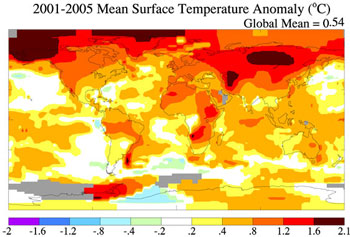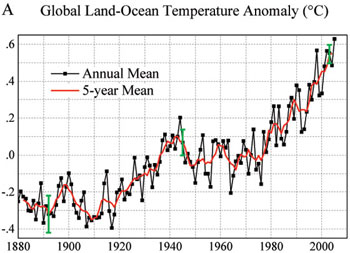Global warming: Earth’s temperature near highest level in a million years
Global warming: Earth’s temperature near highest level in a million years
mongabay.com
September 25, 2006
Earth may nearing its warmest level in the last million years according to a paper published by NASA scientists in the Proceedings of the National Academy of Sciences.
James Hansen of NASA’s Goddard Institute for Space Studies in New York City and colleagues report that “Earth is now reaching and passing through the warmest levels in the current interglacial period” and that global temperature may be within one degree Celsius (1.8°F) of the maximum temperature of the past million years.
“That means that further global warming of 1 degree Celsius defines a critical level. If warming is kept less than that, effects of global warming may be relatively manageable,” said Hansen. “During the warmest interglacial periods the Earth was reasonably similar to today. But if further global warming reaches 2 or 3 degrees Celsius, we will likely see changes that make Earth a different planet than the one we know. The last time it was that warm was in the middle Pliocene, about three million years ago, when sea level was estimated to have been about 25 meters (80 feet) higher than today.”

Because of a rapid warming trend over the past 30 years, the Earth is now reaching and passing through the warmest levels seen in the last 12,000 years. This color-coded map shows how temperatures changed on average from 2001-2005. 2005 was the warmest ranked year on record. Dark red indicates the greatest warming and purple indicates the greatest cooling. Credit: NASA |
Hansen said that the impact of climate change is already evident in studies that have found warmer temperatures are causing plant and animal species to migrate towards the north and south poles.
The researchers also warn that increased temperature difference between the Western and Eastern Pacific may boost the likelihood of strong El Niños, events characterized by the movement of warm surface waters in the West Pacific eastward toward South America. El Niños typically wreak weather havoc, causing severe storms in some parts of the world and devastating droughts in other regions.
A news release from NASA follows.
NASA Study Finds World Warmth Edging Ancient Levels
A new study by NASA scientists finds that the world’s temperature is reaching a level that has not been seen in thousands of years.

Image left: Data from this study reveal that the Earth has been warming approximately 0.2 degrees Celsius (0.36 Fahrenheit) per decade for the past 30 years. This rapid warming has brought global temperature to within about one degree Celsius 1.8 Degrees Fahrenheit) of the maximum estimated temperature during the past million years, when sea level was about 25 meters (82 feet) higher than today. NASA RELATED ARTICLES Earth at Warmest in 400 Years. There is sufficient evidence from tree rings, boreholes, retreating glaciers, and other “proxies” of past surface temperatures to say with a high level of confidence that the last few decades of the 20th century were warmer than any comparable period in the last 400 years, according to a new report from the National Research Council. Less confidence can be placed in proxy-based reconstructions of surface temperatures for A.D. 900 to 1600, said the committee that wrote the report, although the available proxy evidence does indicate that many locations were warmer during the past 25 years than during any other 25-year period since 900. Very little confidence can be placed in statements about average global surface temperatures prior to A.D. 900 because the proxy data for that time frame are sparse, the committee added 2006 on pace to be warmest year on record in the US. The average temperature for the continental United States from January through June 2006 was the warmest first half of any year since records began in 1895, according to scientists at the National Oceanic & Atmospheric Administration’s (NOAA) National Climatic Data Center (NCDC) World temperatures highest in 1200 years. World temperatures are higher than in any period over the last 1,200 years, according to a study published in the current issue of Science. In reaching their conclusion, a research team from the University of East Anglia in Britain analyzed 14 sets of temperature records including data from rings, fossil shells, ice cores, temperature records, and historical documents from North America, Europe and East Asia. Carbon dioxide level highest in 650,000 years. Carbon dioxide levels are now 27 percent higher than at any point in the last 650,000 years, according to research into Antarctic ice cores published on Thursday in Science. Analysis of carbon dioxide in the ancient Antarctic ice showed that at no point in the past 650,000 years did levels approach today’s carbon dioxide concentrations of around 380 parts per million (ppm). The Intergovernmental Panel on Climate Change (IPCC) projects that atmospheric carbon dioxide levels could reach 450-550 ppm by 2050, possibly resulting in higher temperatures and rising sea levels. There is fear that climate change could create a class of environmental refugees displaced from their homes by rising oceans, increasingly catastrophic weather, and expanding deserts.
|
The study, led by James Hansen of NASA’s Goddard Institute for Space Studies, N.Y., along with scientists from other organizations concludes that, because of a rapid warming trend over the past 30 years, the Earth is now reaching and passing through the warmest levels in the current interglacial period, which has lasted nearly 12,000 years. An “interglacial period” is a time in the Earth’s history when the area of Earth covered by glaciers was similar or smaller than at the present time. Recent warming is forcing species of plants and animals to move toward the north and south poles.
The study used temperatures around the world taken during the last century. Scientists concluded that these data showed the Earth has been warming at the remarkably rapid rate of approximately 0.36° Fahrenheit (0.2° Celsius) per decade for the past 30 years.
“This evidence implies that we are getting close to dangerous levels of human-made pollution,” said Hansen. In recent decades, human-made greenhouse gases have become the largest climate change factor. Greenhouse gases trap heat in the Earth’s atmosphere and warm the surface. Some greenhouse gases, which include water vapor, carbon dioxide, methane, nitrous oxide, and ozone, occur naturally, while others are due to human activities.
The study notes that the world’s warming is greatest at high latitudes of the Northern Hemisphere, and it is larger over land than over ocean areas. The enhanced warming at high latitudes is attributed to effects of ice and snow. As the Earth warms, snow and ice melt, uncovering darker surfaces that absorb more sunlight and increase warming, a process called a positive feedback. Warming is less over ocean than over land because of the great heat capacity of the deep-mixing ocean, which causes warming to occur more slowly there.
Hansen and his colleagues in New York collaborated with David Lea and Martin Medina-Elizade of UCSB to obtain comparisons of recent temperatures with the history of the Earth over the past million years. The California researchers obtained a record of tropical ocean surface temperatures from the magnesium content in the shells of microscopic sea surface animals, as recorded in ocean sediments.
One of the findings from this collaboration is that the Western Equatorial Pacific and Indian Oceans are now as warm as, or warmer than, at any prior time in the Holocene. The Holocene is the relatively warm period that has existed for almost 12,000 years, since the end of the last major ice age. The Western Pacific and Indian Oceans are important because, as these researchers show, temperature change there is indicative of global temperature change. Therefore, by inference, the world as a whole is now as warm as, or warmer than, at any time in the Holocene.
According to Lea, “The Western Pacific is important for another reason, too: it is a major source of heat for the world’s oceans and for the global atmosphere.”
In contrast to the Western Pacific, the researchers find that the Eastern Pacific Ocean has not shown an equal magnitude of warming. They explain the lesser warming in the East Pacific Ocean, near South America, as being due to the fact this region is kept cool by upwelling, rising of deeper colder water to shallower depths. The deep ocean layers have not yet been affected much by human-made warming.
Hansen and his colleagues suggest that the increased temperature difference between the Western and Eastern Pacific may boost the likelihood of strong El Ninos, such as those of 1983 and 1998. An El Nino is an event that typically occurs every several years when the warm surface waters in the West Pacific slosh eastward toward South America, in the process altering weather patterns around the world.
The most important result found by these researchers is that the warming in recent decades has brought global temperature to a level within about one degree Celsius (1.8°F) of the maximum temperature of the past million years. According to Hansen, “That means that further global warming of 1 degree Celsius defines a critical level. If warming is kept less than that, effects of global warming may be relatively manageable. During the warmest interglacial periods the Earth was reasonably similar to today. But if further global warming reaches 2 or 3 degrees Celsius, we will likely see changes that make Earth a different planet than the one we know. The last time it was that warm was in the middle Pliocene, about three million years ago, when sea level was estimated to have been about 25 meters (80 feet) higher than today.”
Global warming is already beginning to have noticeable effects in nature. Plants and animals can survive only within certain climatic zones, so with the warming of recent decades many of them are beginning to migrate poleward. A study that appeared in Nature Magazine in 2003 found that 1700 plant, animal and insect species moved poleward at an average rate of 6 kilometers (about 4 miles) per decade in the last half of the 20th century.
That migration rate is not fast enough to keep up with the current rate of movement of a given temperature zone, which has reached about 40 kilometers (about 25 miles) per decade in the period 1975 to 2005. “Rapid movement of climatic zones is going to be another stress on wildlife,” according to Hansen. “It adds to the stress of habitat loss due to human developments. If we do not slow down the rate of global warming, many species are likely to become extinct. In effect we are pushing them off the planet.”
This article uses information and quotes from WWF.














